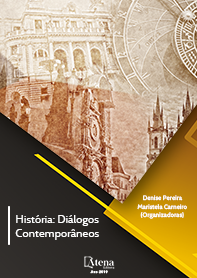
CAMPESINATO NA DIOCESE DE GOIÁS: MEMÓRIAS DAS LUTAS E COM D. TOMÁS BALDUÍNO
Pesquisa que procura discutir o
discurso e a representação dos camponeses
em sua luta tendo a Diocese de Goiás, via
bispado de D. Tomas Balduíno, como instituição
que esteve presente e se envolveu ativamente
nos movimentos de luta e permanência na
terra, com intensa mobilização e formação
nas experiências que foram surgindo ao longo
das décadas de 1970-80. A partir da troca de
saberes entre camponeses e membros da Igreja
da Libertação, como ficou conhecida, nascem
outras instituições que foram importantes
instrumentos e espaço para conquistas em
relação à terra. Surgem os Sindicatos dos
Trabalhadores Rurais, Comissão Pastoral da
Terra (CPT) e, posteriormente, o Movimento
dos Trabalhadores Rurais Sem Terra – MST
dentre tantas outras instituições e embates
que foram sendo reinventados ao longo dessas
décadas. Procura-se com as memórias de
alguns destes atores sociais, camponeses e
representantes da Diocese de Goiás entender
como foram sendo apreendidos culturalmente
o processo da luta em prol dos campesinos,
momento ao qual, nestas memórias coletivas
ou individuais podemos compreender como se
fora produzida a luta e sua intensa mobilização,
o formar-se coletivamente. Destaque da
presença importante, para estes embates, do
bispo D. Tomás Balduíno, cuja vida sacerdotal
fora dedicada em ouvir, aprender e incentivar a
luta dos camponeses. Leituras essenciais para
nossa pesquisa como Walter Benjamin (1994),
E. P. Thompson (1987), Jadir de Morais Pessoa
(1999), Carlos Rodrigues Brandão (1986),
José de Souza Martins (1990), Maria Yedda
Linhares; Francisco Carlos Teixeira (1999),
Paul Thompson (2002), Ecléia Bosi (1994)
dentre outros. Somem-se a todo este debate
os documentos produzidos no trabalho da
caminhada da Diocese de Goiás e da Comissão
Pastoral da Terra que foram disponibilizados
para que pudéssemos acessar as memórias
dos camponeses que serviram como instrumentos para pensar e desenvolver leituras
possíveis acerca dos camponeses em Goiás, com especificidade na região da Diocese
de Goiás. Assim, o discurso e as inúmeras representações dos envolvidos nos
trabalhos da Diocese de Goiás, quer seja os camponeses, como as narrativas de José
Bernardino da Cunha e Moris Joaquim da Costa, dentre outros, como lavradores de
Jussara, Itapirapuã, Novo Brasil e representantes sindicais de outros municípios traz
à tona memórias que narram e contam um pouco desse passado de luta e parceria
profícua entre o papel profético de D. Tomás Balduíno e os embates experienciados
pelos camponeses na região de Goiás.
CAMPESINATO NA DIOCESE DE GOIÁS: MEMÓRIAS DAS LUTAS E COM D. TOMÁS BALDUÍNO
-
DOI: 10.22533/at.ed.59419230811
-
Palavras-chave: Camponeses. Memória. Diocese de Goiás. Luta e Terra.
-
Keywords: Peasants. Memory. Diocese of Goiás. Struggle and Land.
-
Abstract:
Research that seeks to discuss the peasants’ discourse and representation
in their struggle by having the Diocese of Goiás, via bishopric of D. Tomas Balduino,
as an institution that was present and actively involved in the movements of struggle
and permanence in the countryside, with intense mobilization and formation in the
experiences that emerged throughout the decades of 1970-80. From the exchange of
knowledge among peasants and members of the Liberation Church, as it became known,
other institutions were born that were important instruments and space for conquests
in relation to the land. The Rural Workers’ Unions, the Pastoral Land Commission
(CPT) and, later, the Landless Rural Workers’ Movement (MST) are emerged among
many other institutions and struggles that have been reinvented throughout these
decades. It is sought with the memories of some of these social actors, peasants and
representatives of the Diocese of Goiás to understand how the process of the struggle for
the peasants was being culturally seized, at which time, in these collective or individual
memories we can understand how it had seen produced the struggle and its intense
mobilization, the forming itself collectively. It is highlighted the important presence, for
these conflicts, of Bishop D. Tomás Balduíno, whose priestly life had been dedicated
to listening, learning and encouraging the peasants’ struggle. Essential readings for
our research such as Walter Benjamin (1994), E. P. Thompson (1987), Jadir de Morais
Pessoa (1999), Carlos Rodrigues Brandão (1986), José de Souza Martins (1990),
Maria Yedda Linhares; Francisco Carlos Teixeira (1999), Paul Thompson (2002),
Ecléia Bosi (1994) and others. Add to this whole debate the documents produced in
the work of the Diocese of Goiás and the Pastoral Land Commission that were made
available so that we could access the peasants’ memories who served as tools to
think and develop possible readings about the peasants in Goiás, with specificity in the
region of the Diocese of Goiás. Thus, the discourse and numerous representations of
those ones involved in the work of the Diocese of Goiás, whether they are peasants,
or the narratives of José Bernardino da Cunha and Moris Joaquim da Costa, among
others, as farmers from Jussara, Itapirapuã, Novo Brazil and union representatives
from other municipalities elicits memories that narrate and tell a little about this past of
struggle and fruitful partnership between the prophetic role of D. Tomás Balduíno and
the clashes experienced by the peasants in the region of Goiás.
-
Número de páginas: 15
- Valtuir Moreira da Silva
- Damiana Antônia Coelho


